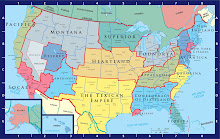
AREA
169,000 sq.m. (8th)
POPULATION
3,913,000 (15h)
DENSITY
23 people per square mile.
CAPITAL
Santa Fe
STATES
None (organized into tribal territories)
RELIGION
Various (tribal based)
LANGUAGE
Various (tribal based), English
NATL INCOME
120 billion.
MEDIAN INCOME
$30,735 (18th)
ECONOMY
Amerindia’s economy is below average. The government has a generally isolationist slant, and due to its insistence on an organized tribal structure and civic life, is slow to adapt and adopt new technology. Its cities, including Albuquerque and Tucson, have declined since the Division. There are significant possibilities in natural resources and mining, but the dominant environmentalist faction of the government has refused to utilize those resources. As a result, the nation has developed a largely independent structure that precludes financial growth, although the westernmost corner’s proximity to Nevada has made it a trafficking point for illegal goods. Recently the ANTU nations have tried to incentivize Amerindia to producing cotton. The cost of living is low.
OVERVIEW
Like Deseret-Utah, Amerindia was created in the Redivision of 1994, carved from the former nation of Arizona (in existence from 1981-1994, comprising the former states of New Mexico, Arizona, Nevada and Utah) after frequent cultural clashes between the four states. From the beginning, the nation organized along tribal lines instead of political parties, and allowed any immigrant from any other nation immediate citizenship and land ownership if that immigrant could prove Native American blood. Amerindia does not maintain a strong international relevance or economic position. Corruption in the administration of first President Wilma Pearl Mankiller led to a massive infrastructure overhaul by popular 2nd President, Ben Nighthorse Campbell. The administration of Texican immigrant Thomas Jeffrey Cole was overturned when it was revealed that Cole had promised the Texican government drilling contracts in Amerindian land, and allegedly further cession of Amerindian territory to the growing Texican Empire. Cole was removed in a joint Navajo-Chippewa coup led by Mark Maryboy and current president Winona LaDuke. Amerindia remain a poor nation, but one that has more successfully made the transition to a green economy than most.
HEAD OF STATE

Winona LaDuke,
Chippewa Tribe

Mark Maryboy,
Navajo Tribe









































